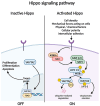Molecular Mechanisms in Tumorigenesis of Hepatocellular Carcinoma and in Target Treatments-An Overview
- PMID: 38927059
- PMCID: PMC11201617
- DOI: 10.3390/biom14060656
Molecular Mechanisms in Tumorigenesis of Hepatocellular Carcinoma and in Target Treatments-An Overview
Abstract
Hepatocellular carcinoma is the most common primary malignancy of the liver, with hepatocellular differentiation. It is ranked sixth among the most common cancers worldwide and is the third leading cause of cancer-related deaths. The most important etiological factors discussed here are viral infection (HBV, HCV), exposure to aflatoxin B1, metabolic syndrome, and obesity (as an independent factor). Directly or indirectly, they induce chromosomal aberrations, mutations, and epigenetic changes in specific genes involved in intracellular signaling pathways, responsible for synthesis of growth factors, cell proliferation, differentiation, survival, the metastasis process (including the epithelial-mesenchymal transition and the expression of adhesion molecules), and angiogenesis. All these disrupted molecular mechanisms contribute to hepatocarcinogenesis. Furthermore, equally important is the interaction between tumor cells and the components of the tumor microenvironment: inflammatory cells and macrophages-predominantly with a pro-tumoral role-hepatic stellate cells, tumor-associated fibroblasts, cancer stem cells, extracellular vesicles, and the extracellular matrix. In this paper, we reviewed the molecular biology of hepatocellular carcinoma and the intricate mechanisms involved in hepatocarcinogenesis, and we highlighted how certain signaling pathways can be pharmacologically influenced at various levels with specific molecules. Additionally, we mentioned several examples of recent clinical trials and briefly described the current treatment protocol according to the NCCN guidelines.
Keywords: TERT promoter mutation; WNT/β-catenin; exosomes; hepatocellular carcinoma; histone methylation; immune checkpoint inhibitors; p53; telomere shortening; tumoral microenvironment.
Conflict of interest statement
The authors declare no conflicts of interest.
Figures







Similar articles
-
Androgen receptor drives hepatocellular carcinogenesis by activating enhancer of zeste homolog 2-mediated Wnt/β-catenin signaling.EBioMedicine. 2018 Sep;35:155-166. doi: 10.1016/j.ebiom.2018.08.043. Epub 2018 Aug 24. EBioMedicine. 2018. PMID: 30150059 Free PMC article.
-
Hepatic stellate cells and extracellular matrix in hepatocellular carcinoma: more complicated than ever.Liver Int. 2014 Jul;34(6):834-43. doi: 10.1111/liv.12465. Epub 2014 Feb 12. Liver Int. 2014. PMID: 24397349 Review.
-
Detection of epigenetic aberrations in the development of hepatocellular carcinoma.Methods Mol Biol. 2015;1238:709-31. doi: 10.1007/978-1-4939-1804-1_37. Methods Mol Biol. 2015. PMID: 25421688 Review.
-
Acidic Microenvironment Up-Regulates Exosomal miR-21 and miR-10b in Early-Stage Hepatocellular Carcinoma to Promote Cancer Cell Proliferation and Metastasis.Theranostics. 2019 Mar 16;9(7):1965-1979. doi: 10.7150/thno.30958. eCollection 2019. Theranostics. 2019. PMID: 31037150 Free PMC article.
-
The tumor microenvironment in hepatocellular carcinoma: current status and therapeutic targets.Semin Cancer Biol. 2011 Feb;21(1):35-43. doi: 10.1016/j.semcancer.2010.10.007. Epub 2010 Oct 12. Semin Cancer Biol. 2011. PMID: 20946957 Free PMC article. Review.
Cited by
-
Develop a prognostic and drug therapy efficacy prediction model for hepatocellular carcinoma based on telomere maintenance-associated genes.Front Oncol. 2025 Feb 14;15:1544173. doi: 10.3389/fonc.2025.1544173. eCollection 2025. Front Oncol. 2025. PMID: 40027133 Free PMC article.
-
Unraveling TRPV1's Role in Cancer: Expression, Modulation, and Therapeutic Opportunities with Capsaicin.Molecules. 2024 Oct 7;29(19):4729. doi: 10.3390/molecules29194729. Molecules. 2024. PMID: 39407657 Free PMC article. Review.
-
Overexpression pattern, function, and clinical value of proteasome 26S subunit non-ATPase 6 in hepatocellular carcinoma.World J Clin Oncol. 2025 Feb 24;16(2):99839. doi: 10.5306/wjco.v16.i2.99839. World J Clin Oncol. 2025. PMID: 39995557 Free PMC article.
-
Viral oncogenesis in cancer: from mechanisms to therapeutics.Signal Transduct Target Ther. 2025 May 12;10(1):151. doi: 10.1038/s41392-025-02197-9. Signal Transduct Target Ther. 2025. PMID: 40350456 Free PMC article. Review.
-
Gut Microbial Postbiotics as Potential Therapeutics for Lymphoma: Proteomics Insights of the Synergistic Effects of Nisin and Urolithin B Against Human Lymphoma Cells.Int J Mol Sci. 2025 Jul 16;26(14):6829. doi: 10.3390/ijms26146829. Int J Mol Sci. 2025. PMID: 40725093 Free PMC article.
References
-
- Torbenson M.S., Ng I.O.L., Park Y.N., Roncalli M., Sakarnato M. Hepatocelullar carcinoma. In: Paradis V., Fukayama M., Park Y.N., Schirmacher P., editors. WHO Classification of Tumors Editorial Board. Digestive System Tumours. 5th ed. International Agency for Research on Cancer; Lyon, France: 2019. pp. 229–232.
Publication types
MeSH terms
LinkOut - more resources
Full Text Sources
Medical
Research Materials
Miscellaneous

